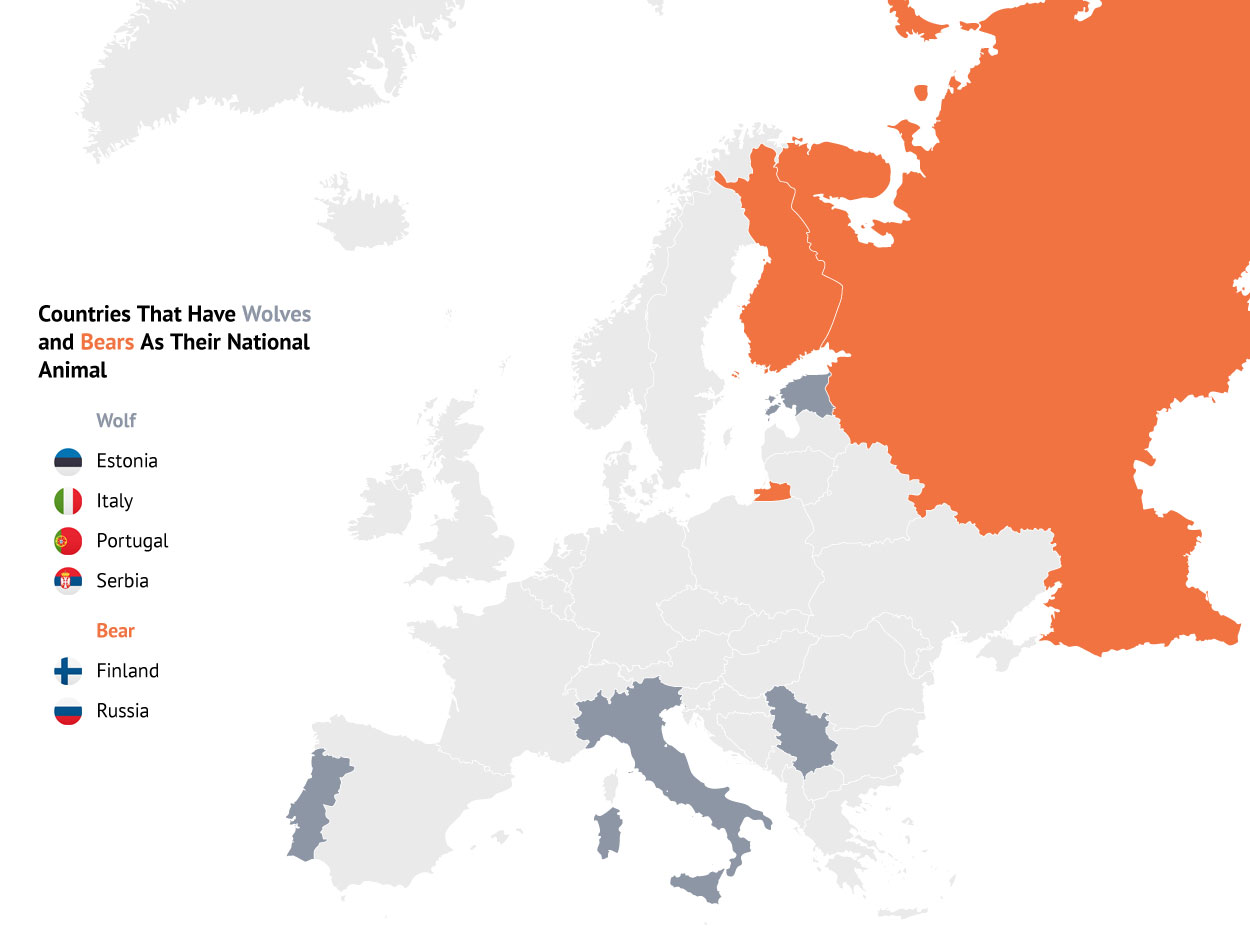Totem animals used to characterize tribes, empires, and now countries. Since ancient times people enjoyed associating themselves with animals: strong as a bear, fast as a hare, faithful as a wolf.
That’s why almost every European country has a national animal. Many even have more than a one. Let’s take a look:


![]()
A small note: some animals have confusing names and that’s why we listed them simply as a ‘bird’, ‘butterfly’ and the like.
While almost every country has a national animal, some states lack any. Bosnia and Herzegovina, San Marino, Slovakia, Switzerland, Ukraine, and the Vatican have no national animal.

Two microstates and three young countries that have emerged in the 90s during the fall of Communism make up a large part of this list.
Of the countries that have almost half (45 %) have at least two national animals. Finland and the UK have even five!

Countries with a large number of national animals are concentrated in the North of Europe near the Northern seas of the continent.
The national animal can be an ordinary animal, but it can also be a mythical or a heraldic one.
Mythical animals are the ones that have never existed or those that possess magical abilities.

According to the map, most of them are concentrated in the center of Europe.
A heraldic animal is the one that is widely used on the coats of arms of families, clans, and countries. The map differs little from the previous one. Most of the examples are again concentrated in Central Europe.

If we count the animals we’ll see that the two most popular animals in Europe are lions and eagles. Our obsession with cats has gone to the state level!

Benelux, Norway and the UK stand out. All countries are historically linked and so their choice of loin as a national symbol is not surprising. Though, it’s surprising that countries with not the best climate for lions (rainy London and snowy Oslo) did choose lions, while only a couple of Slavic countries chose lions in the South of Europe.
Eagles are concentrated in three places:

Central Europe, the Balkans, and Russia. Eagles are appreciated by Slavs and German-speaking countries.
Wolves are quite popular, but scattered throughout Europe:

Neighboring Finland and Russia have bears as their national animal. If we go on with animals that some neighbors share, we’ll end up with a bison and a lynx:

It’s worth noting that five countries in Europe use different bulls. In addition to Belarusian and Polish bison, people in Andorra worship cows, Spaniards fighting bulls and Moldova has chosen the extinct aurochs as its national animal.
Besides bison Belarus and Poland are connected by storks:

Together with Lithuania, this trio takes us back to the times of the Polish—Lithuanian Commonwealth. Portuguese and French like roosters and the tiny ladybird is the choice of Finns and Latvians.
Some statistics:

Important addition: we’ve decided that only those animals that have no analogs in real animals should be put in the ‘mythical’ section. Meaning that the British unicorn was counted as a horse and the Hungarian turul as a bird.
The only mythical creature is the Welsh Dragon Y Ddraig Goch that the Welsh have on their flag.
To conclude, a big beautiful picture to share. Enjoy:

How This Article Was Created Before such an article is published on the Dialogue it goes through many stages. It all starts with the collection of the data, its sorting, and analysis. Later, maps are created along with the legends and other images used in the article. In parallel, the article is written. Some articles are shorter, some are longer. After checking both the text and the images their translation to other languages begins. We try to adapt the article as much as possible for other languages, so even the countries in the pictures are changed in alphabetical order. It all takes time since it’s done manually, but the quality is important to us. After the translation, the article is uploaded to the site, it is promoted and we move on to the next material. We don’t have a separate author, designer, editor, translator, SEO-specialist and so on. Everything on the Dialogue is being done by only three people. Here we are. Many websites not only don’t have photos of the Editorial Board but don’t even put the names of the authors. We try to be as open as possible so that our readers can see who wrote it and where. We think that it is important. We’re growing in quality and quantity. We’ve completely redesigned the website last year at our expense as well as improved the quality of our articles. You can look at our old materials and see how better we’ve become. We want to follow this positive trend and create more interesting and great articles, but we have our limitations. For example, in order to publish more articles, we need money. In that case, we could hire additional authors or translators so that they could take over some of the work. Same goes for the website: it still has some imperfections, and to improve it we also need money and time. That’s why we need your help. If you like this article then please support us financially. Just a few dollars would be of great help to us. If you have any questions or doubts you can always ask us directly. Thank you. Stefan



























Comments